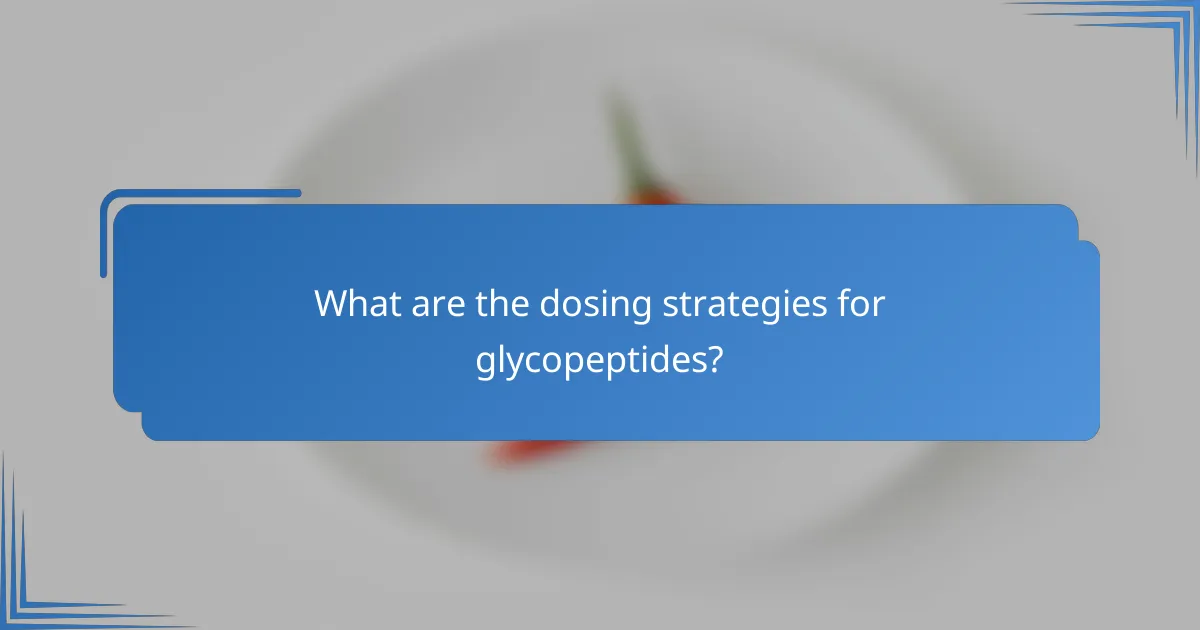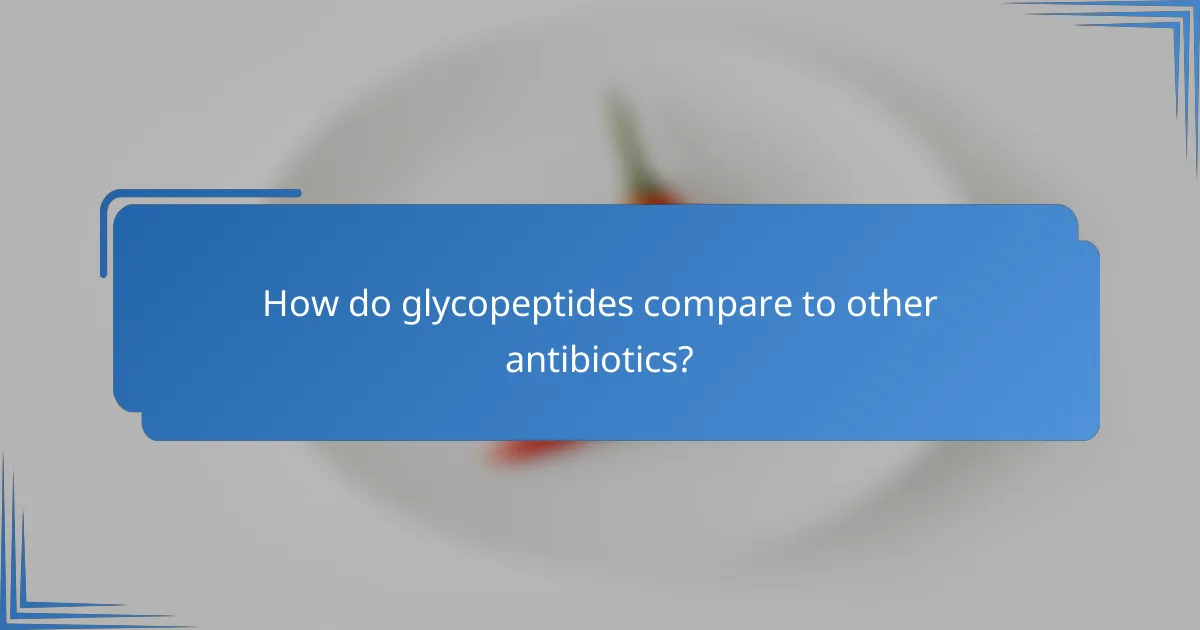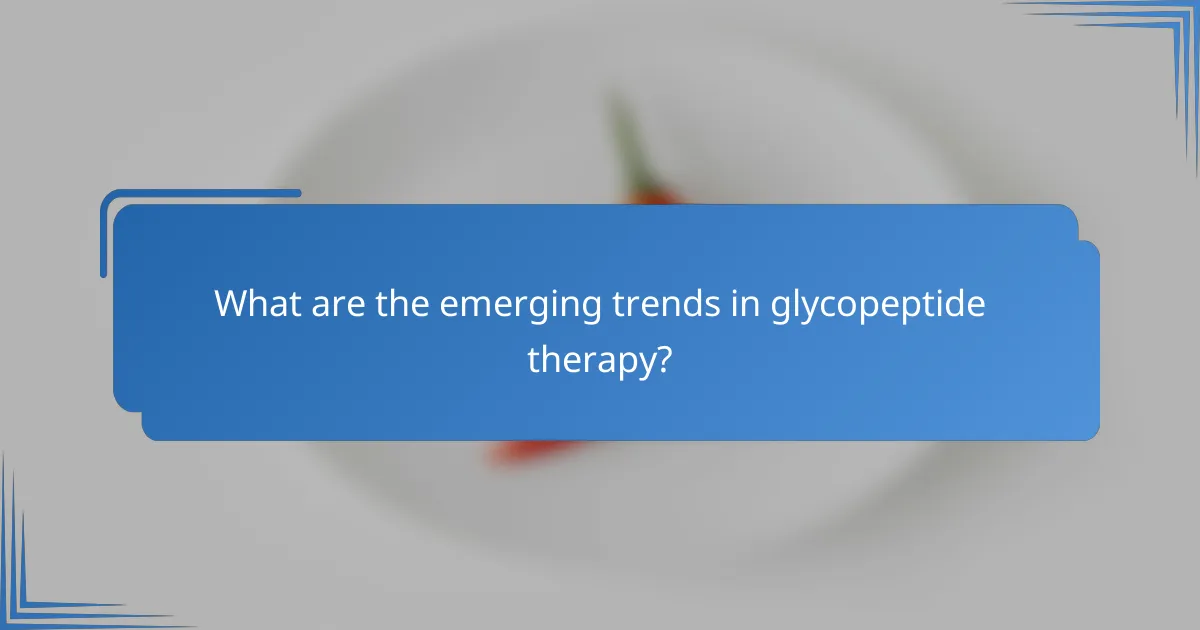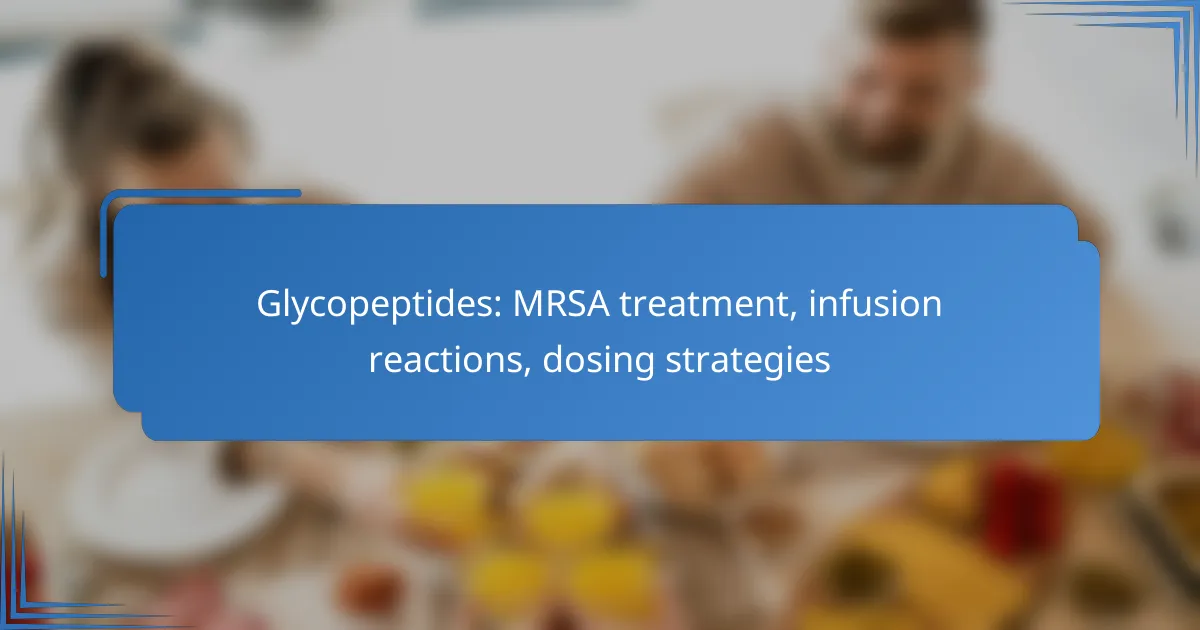Glycopeptides, including vancomycin, daptomycin, and teicoplanin, are essential in treating infections caused by methicillin-resistant Staphylococcus aureus (MRSA). While effective, these antibiotics can lead to infusion reactions, particularly with rapid administration, necessitating careful monitoring. Dosing strategies, especially for vancomycin, require weight-based calculations and serum level assessments to optimize efficacy and reduce toxicity.

What are the effective glycopeptide treatments for MRSA?
Effective glycopeptide treatments for MRSA include vancomycin, daptomycin, and teicoplanin. These antibiotics are crucial in managing infections caused by methicillin-resistant Staphylococcus aureus, each with distinct mechanisms and considerations for use.
Vancomycin
Vancomycin is a first-line treatment for MRSA infections, functioning by inhibiting bacterial cell wall synthesis. It is typically administered intravenously for serious infections, with dosing adjusted based on patient weight and renal function, often ranging from 15 to 20 mg/kg every 8 to 12 hours.
Monitoring serum levels is essential to avoid toxicity and ensure efficacy, with target trough levels generally between 10 to 20 mcg/mL. Infusion reactions, such as “red man syndrome,” can occur if infused too rapidly, so a slow infusion rate is recommended.
Daptomycin
Daptomycin is another effective option for MRSA, particularly for skin and soft tissue infections. It works by disrupting bacterial cell membrane function, leading to cell death. Dosing typically involves 4 to 6 mg/kg once daily, depending on the severity of the infection.
This medication is not suitable for pneumonia due to inactivation by pulmonary surfactant. Monitoring for muscle-related side effects, such as elevated creatine kinase levels, is important during treatment.
Teicoplanin
Teicoplanin is less commonly used but is effective against MRSA, particularly in Europe. Similar to vancomycin, it inhibits cell wall synthesis and is often given intravenously, with a loading dose followed by maintenance doses of 6 to 12 mg/kg once daily.
Teicoplanin has a longer half-life, allowing for less frequent dosing, which can improve patient compliance. It is generally well-tolerated, but monitoring for hypersensitivity reactions is advisable during treatment.

How do infusion reactions occur with glycopeptides?
Infusion reactions with glycopeptides, such as vancomycin, typically arise due to the rapid infusion of the drug, leading to histamine release and subsequent symptoms. These reactions can occur shortly after administration and may vary in severity, necessitating careful monitoring during treatment.
Common symptoms of infusion reactions
Infusion reactions can manifest as a range of symptoms, including flushing, rash, pruritus, and hypotension. Patients may also experience chills, fever, or difficulty breathing in more severe cases. Symptoms often appear within minutes to hours after the infusion begins.
In some instances, the “red man syndrome” is specifically associated with rapid vancomycin infusion, characterized by a red rash primarily on the upper body. Recognizing these symptoms early is crucial for effective management.
Management strategies for infusion reactions
To manage infusion reactions effectively, it is recommended to slow the infusion rate of glycopeptides, especially if symptoms arise. For mild reactions, premedication with antihistamines may alleviate symptoms and allow for continued treatment.
In cases of severe reactions, discontinuing the infusion and providing supportive care, such as intravenous fluids or corticosteroids, may be necessary. Regular monitoring of vital signs during infusion can help identify adverse reactions promptly, ensuring patient safety.

What are the dosing strategies for glycopeptides?
Dosing strategies for glycopeptides, particularly Vancomycin, typically involve weight-based calculations and careful monitoring of serum levels to ensure efficacy while minimizing toxicity. These strategies are crucial for optimizing treatment outcomes in infections caused by resistant bacteria like MRSA.
Weight-based dosing for Vancomycin
Weight-based dosing for Vancomycin generally starts at around 15 to 20 mg/kg per dose, administered every 8 to 12 hours, depending on the severity of the infection and the patient’s renal function. This approach helps to achieve therapeutic drug levels while reducing the risk of adverse effects.
For example, a patient weighing 70 kg may receive an initial dose of 1,050 to 1,400 mg. Adjustments may be necessary based on clinical response and renal function, particularly in patients with compromised kidney function.
Monitoring serum levels
Monitoring serum levels of Vancomycin is essential to ensure that drug concentrations remain within the therapeutic range, typically between 10 to 20 mg/L for most infections. Levels should be checked after the third or fourth dose to guide further dosing adjustments.
It is critical to avoid both subtherapeutic levels, which can lead to treatment failure, and supratherapeutic levels, which increase the risk of nephrotoxicity. Regular monitoring helps clinicians make informed decisions about dosing frequency and adjustments based on individual patient needs.

What are the key considerations for glycopeptide use in Canada?
When using glycopeptides in Canada, it is essential to consider regulatory guidelines, local resistance patterns, and patient-specific factors. These considerations help ensure effective treatment of MRSA infections while minimizing risks associated with infusion reactions and dosing errors.
Regulatory guidelines
In Canada, glycopeptides like vancomycin and teicoplanin are regulated by Health Canada, which mandates adherence to specific dosing protocols and monitoring practices. Clinicians must follow the Canadian guidelines for the treatment of MRSA, which recommend initial dosing based on the severity of the infection and the patient’s renal function.
For example, vancomycin dosing typically starts at 15-20 mg/kg every 8-12 hours, adjusted according to therapeutic drug monitoring. It is crucial to monitor serum levels to avoid toxicity, particularly nephrotoxicity, which can occur with high concentrations.
Local resistance patterns
Understanding local resistance patterns is vital for the effective use of glycopeptides in treating MRSA. In Canada, resistance rates can vary significantly by region, impacting treatment decisions. Regular surveillance data from local hospitals and public health agencies should inform clinicians about the prevalence of resistant strains.
For instance, if local data indicate a high prevalence of vancomycin-resistant enterococci (VRE), alternative therapies may need to be considered. Clinicians should stay updated on resistance trends to optimize treatment regimens and improve patient outcomes.

How do glycopeptides compare to other antibiotics?
Glycopeptides are a class of antibiotics primarily used to treat infections caused by Gram-positive bacteria, particularly MRSA. They are often compared to other antibiotic classes, such as beta-lactams and linezolid, to determine their effectiveness and suitability for specific infections.
Glycopeptides vs. beta-lactams
Glycopeptides, like vancomycin, are effective against resistant strains of bacteria, such as MRSA, while beta-lactams, including penicillins and cephalosporins, are generally ineffective against these organisms. The mechanism of action for glycopeptides involves inhibiting cell wall synthesis, which is crucial for bacterial survival.
When considering treatment options, it is important to note that glycopeptides may require higher doses and longer infusion times compared to beta-lactams. For instance, vancomycin is often administered over a period of at least 60 minutes to minimize infusion reactions, whereas many beta-lactams can be infused more quickly.
Glycopeptides vs. linezolid
Linezolid is an oxazolidinone antibiotic that is also effective against MRSA and has a different mechanism of action, inhibiting protein synthesis. While both glycopeptides and linezolid are effective for treating MRSA infections, linezolid may be preferred in cases where oral administration is necessary, as it is available in both intravenous and oral forms.
In terms of side effects, glycopeptides can lead to nephrotoxicity and infusion reactions, while linezolid may cause myelosuppression and peripheral neuropathy with prolonged use. Therefore, the choice between these antibiotics should consider the patient’s overall health, the severity of the infection, and potential side effects.

What are the emerging trends in glycopeptide therapy?
Emerging trends in glycopeptide therapy focus on innovative formulations, understanding resistance mechanisms, and improving treatment strategies for MRSA. These developments aim to enhance efficacy, reduce side effects, and address the growing challenge of antibiotic resistance.
New formulations and delivery methods
Recent advancements in glycopeptide therapy include new formulations such as liposomal vancomycin, which improves drug delivery and reduces toxicity. These formulations can enhance the drug’s pharmacokinetics, allowing for more effective treatment with potentially fewer side effects.
Additionally, alternative delivery methods, such as subcutaneous or intramuscular routes, are being explored to improve patient compliance and reduce the need for intravenous administration. These methods may offer more convenient options for outpatient treatment.
Research on resistance mechanisms
Understanding the mechanisms of resistance in MRSA is crucial for developing effective glycopeptide therapies. Research indicates that modifications in bacterial cell wall synthesis and the emergence of alternative pathways can lead to reduced susceptibility to glycopeptides.
Ongoing studies aim to identify genetic markers associated with resistance, which can help guide treatment decisions and inform the development of new therapeutic agents. This knowledge is essential for staying ahead of evolving bacterial strains.
Future directions in MRSA treatment
Future directions in MRSA treatment with glycopeptides may involve combination therapies that enhance efficacy and minimize resistance development. Combining glycopeptides with other antibiotics or adjuvants could provide a synergistic effect, improving overall treatment outcomes.
Moreover, personalized medicine approaches, utilizing pharmacogenomics, may allow for tailored glycopeptide dosing strategies based on individual patient profiles. This could lead to more effective and safer treatment regimens for MRSA infections.
